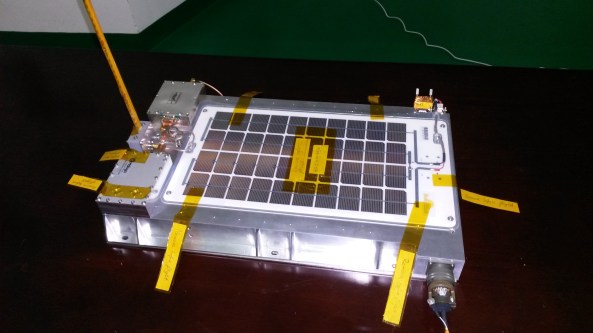
LX0OHB-4M amateur radio lunar payload – Credit LuxSpace
The integration of the LX0OHB-4M amateur radio payload was completed on Sunday night, October 12 and is now ready to launch.
The onboard clock has been adjusted to start JT65B (145.980 MHz) at the UTC minute +/-1 second. It is likely to drift during the mission, and manual offset introduction will be required after a week or so. The launch date is October 23 at 1759 UTC.

Chang Zheng CZ-3C/G2 launch vehicle at Xichang carrying the 4M payload – Credit LuxSpace
Beginning of transmission of 4M will start between 1917 UTC and 1927 UTC. Refer to the provided maps and animations links in the blog section (see also older messages) to determine your visibility. Alternatively, use the ‘tracking’ section where you can compute your tracking elements by introducing your geographic coordinates. The table can be copied/pasted into a text file. As the apparent movement will be close (and closer) to the one one of the Moon, manual pointing is easy but for the largest arrays. We’ll try to publish equivalent TLE’s to input in usual tracking software.
The link budget is quite tight, but the first hours should give comfortable signals. QSB is to be expected.
As JT65B is used: please remind those not yet too familiar with it that the receiver must not be tuned during the transmission. A dedicated webpage is being written to detail the procedure.
A dedicated java application is also available to automatically transmit the decoded messages to the 4M website and ease the data collection. (Thanks to LSE Space). Alternatively, you can also send the decoded messages by eMail, sending the ALL.txt file.
For those not wishing to use JT65B, please record the signals (11025s/s, 8or 16 bits, mono), taking care not to saturate the recording and NO MP3 please.
SpectrumLab is an excellent choice, although some may wish to use simpler recording software.
You can imagine that the team is quite eager to receive the first reports, so, do not hesitate to mail immediately, send decoded messages or even phone or text me at +352 661 678 986.
Our friends of IC CMalaga are also quite eager to receive the results of their radiation dosimeter experiment.
Basic rules of the contest have been delineated in the blog section. Complete rules will be published soon.
Stay tuned on our website or Facebook page.
The following is a tentative set of orbital elements that should remain valid from the launch to at least up to the October 27 when using usual classical and simple tracking software that do not integrate Moon.
1 99999U 14298.79728009 .00000066 00000-0 00000-0 0 00006
2 99999 030.6553 295.6956 9746689 147.2577 071.9585 00.10600338000010
The following set is to be used after the flyby from October 28 onwards
1 99999U 14301.79728009 .00000000 00000-0 00000-0 0 00009
2 99999 049.9434 067.2017 6639865 045.9865 124.5019 00.06612018000010
.
Ghislain Ruy LX2RG
Email: ruy@luxspace.lu with “4M Amateur” in the subject
Manfred Memorial Moon Mission (4M) http://moon.luxspace.lu/
Facebook https://www.facebook.com/LuxSpaceSarl
The launch will be broadcast by CNTV/CCTV: http://www.cntv.cn/ or http://english.cntv.cn/ or http://english.cntv.cn/live/p2p/index.shtml
Information animations and some JT65B test files at
https://cloud.luxspace.lu/public.php?service=files&t=33c4a21c09ba3736a55fc09896e463f6
Read the paper 4M Mission: a Lunar FlyBy experiment
http://tinyurl.com/4M-Mission-V3
EME 2014 slides: 4M, A Moon Flyby Mission
http://tinyurl.com/4M-slides-eme2014
4M lunar ham radio payload shipped
https://amsat-uk.org/2014/10/04/4m-lunar-ham-radio-payload-shipped/






You must be logged in to post a comment.